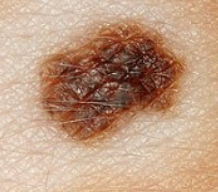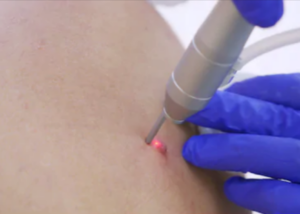
Common mole: very close-up view
Think that a lentigo is the same as a mole (nevus)?
I’ve been told they are, and aren’t, by two different dermatologists.
“Lentigos are superficial tan to brown flat spots on the skin which are often secondary to ultraviolet exposure and will occur on sun exposed areas,” says Kally Papantoniou, MD, FAAD, with Simply Dermatology in NY.
“They are formed by an increase in the number of melanocytes in the base of the epidermis.
“Because of the superficial nature of lentigos they are also easier to remove with laser treatments, and lightening is also possible with creams and chemical peels.
“A melanocytic nevus or mole is usually a darker spot, and will often be raised.
“It is composed of nests of melanocytes which are clustered together and they occur at the base of the epidermis and will extend deeper into the dermis.
“The deeper component to a mole is what makes it difficult to remove superficially without regrowth of the mole occurring.”
Keep in mind that moles can be light brown or tan, and that sometimes, a lentigo can be more like a milk chocolate color.
But Dr. Kally does explain that there’s a difference between these two types of pigmented lesions.

Lentigo: very closeup view
What you see on your leg that looks like a common mole may actually be a lentigo, or vice versa.
It’s not all that uncommon for a person over the age of 40 to acquire new lentigos, but they may appear to a dermatologist to be moles.
A biopsy will distinguish one from the other.
A new lentigo or mole, by the way, in middle age, is nothing to be alarmed about.
However, if you notice a new spot, have a dermatologist check it, and include it in your monthly self-skin exams for any signs of evolution: dynamic changes over a period of several months; fast increase in size (especially if asymmetrical); reds or maroons in it; portions turning black; development of crusting or bleeding.
Here is a second dermatologist’s explanation of the difference between a mole and a lentigo.

 is a board certified dermatologist specializing in cosmetic, laser and surgical dermatology.
is a board certified dermatologist specializing in cosmetic, laser and surgical dermatology.







































